
Effect of Artificial Light Source on the Growth and Quality of Lettuce
ⒸThe Korean Environmental Sciences Society. All rights reserved.
This is an Open-Access article distributed under the terms of the Creative Commons Attribution Non-Commercial License (http://creativecommons.org/licenses/by-nc/3.0) which permits unrestricted non-commercial use, distribution, and reproduction in any medium, provided the original work is properly cited.
Abstract
Variations in lettuce growth and quality were observed depending on the type of artificial light source. The RGB LED treatment resulted in thick leaf development, leading to higher fresh weight, dry weight, and relative growth rates. Two cultivars, “Tomalin” and “seonpunggold,” exhibited increased anthocyanin content and dark red leaf color under conditions of RGB LED treatment. Additionally, they exhibited high chlorophyll content under conditions of RGB LED and RGBFR LED treatments. Particularly, under Red LED treatment, the plants showed elongated leaves with narrow widths, resulting in a higher leaf shape index and a tendency towards leaf curling. Therefore, RGB LED lighting which appropriately blends red, blue, and green lights, is more effective than single lighr sources at improving lettuce growth and quality.
Keywords:
Artificial light, Emergence, Growth, Leaf area index, Light emitting diode1. Introduction
Recently, due to frequent extreme weather events such as localized heavy rainfall, droughts, and heavy snowfall, various weather anomalies have occurred. Consequently, the damage to human food production is becoming increasingly severe. Because of these changes, there is a growing interest in and research trend towards plant factories, where crops can be produced regardless of external environmental factors (Kim et al., 2011).
Light is not only crucial for the photosynthetic process of plants but also plays a vital role in shaping the morphology of plants, including tissue and organ differentiation, as well as seed germination (Lin et al., 2013). Inadequate light conditions can lead to poor crop growth and various physiological disorders and diseases. Therefore, in controlled environment agriculture, the introduction of facility structures and devices to enhance light efficiency is necessary.
Many studies have been conducted to improve crop growth by utilizing various spectra of light in many crops (Briggs, 1993; Nozue et al., 2010). Especially in South Korea, there has been an increase in the number of farming facilities utilizing artificial lighting to enhance crop productivity in winter greenhouse cultivation of peppers and tomatoes, aiming to increase photosynthesis. However, the type of artificial lighting used for crop cultivation can have different effects on crop growth. Metal halide lamps, for instance, distribute wavelengths across the visible spectrum, making them effective for plant cultivation, but they have low luminous efficacy and a short lifespan. On the other hand, fluorescent lamps have the advantage of being inexpensive but have low luminous efficacy and a limited effective spectrum for photosynthesis (Park et al., 2012).
Light emitting diodes (LEDs) are widely used in greenhouse cultivation due to their many advantages such as small size, durability, long lifespan, low heat emission, and ability to emit specific wavelengths (Massa et al., 2008; Nozue et al., 2010; Lin et al., 2013).
Light quality plays a crucial role in the growth and quality of plants, and LEDs, in particular, offer the advantage of being able to provide light across all wavelengths, including red, green, and blue. This feature makes them useful for controlling photomorphogenesis (Briggs, 1993; Hwang et al., 2004; Nozue et al., 2010).
Red and blue light, which are important energy sources for plant photosynthesis, have the greatest impact on plant growth (Lin et al., 2013). Blue light affects photoperiodic effects, stem growth inhibition, leaf expansion promotion, and gene expression induction (Briggs, 1993), while red light influences shoot and stem growth (Shin et al., 2008) as well as photosynthesis (Yorio et al., 2001). Moreover, research is actively conducted on high-quality crop production using LEDs to supply specific wavelengths, thereby increasing the content of functional components such as β-carotene and anthocyanin in crops or promoting growth (Nishimura et al., 2006; Wu et al., 2007; Li and Kubota, 2009; Lee et al., 2010; Kim et al., 2011).
Lettuce is known to be a commonly used plant in illuminant and light quality research (Yorio et al., 2001; Kim et al., 2011; Lin et al., 2013). However, research on the effects of LED wavelength combinations, appropriate light intensities, and other factors on the growth response and quality of lettuce cultivars remains insufficient.
Therefore, this study aimed to investigate the effects of different types of light sources and LED spectra (red, blue, red + blue + green mixed light and red + blue + green + far-red mixed light) in the greenhouse cultivation environment on the growth and quality of leaf lettuce.
2. Materials and Methods
2.1. Cultivation condition
The lettuce cultivars used in this experiment were 'Tomallin' (Kwonnong, Chungcheongbuk-do, Korea) and 'Seonpunggold' (Kwonnong, Chungcheongbuk-do, Korea). The experiment was conducted at the high-set bench of a 40 m2 glass greenhouse located at Pusan National University in Miryang, Gyeongsangnam-do, South Korea.
The lettuce cultivars 'Tomallin' and 'Seonpunggold' were sown on 162-cell plug trays and grown for 31 days in a greenhouse. After the seedlings developed at least 2 true leaves, they were transplanted into 15 cm diameter pots. The soil used was horticultural soil (Farmhannog, Seoul, Korea), filling 90% of the pots. Throughout the cultivation period, the greenhouse's daytime and nighttime temperatures were set at 20°C. To ensure proper temperature management during the experimental period, temperature and humidity were monitored using a temperature-humidity recorder (TR-72Ui, TSD Corporation, Japan) installed 50 cm above the plants from September 19th to October 25th.
2.2. Artificial light treatment
The artificial light sources used in this experiment included a 400W high-pressure sodium lamp (HPS Ike-Nhip_400W, Il Kwang Electric Co., Ltd., Korea), a 175W metal halide lamp (MH Geolighting, Korea), red LED (R-L, Parus, Korea), blue LED (B-L, Parus, Korea), red + green + blue LED (RGB-L, D&W, Korea), and red + green + blue + far-red LED (RGBFR-L, D&W, Korea). These were used as bulb-type artificial light sources.
The types of LED light used were R-L (630 nm, R), B-L (450 nm, B), RGB-L (R:G:B=6.9:1:2.1, RGB), and RGBFR-L (R:G:B:FR=3.8:3.2:1.8:1.2, RGBFR). The LED lights were installed vertically at a height of 90 cm from the pots and illuminated for 24 hours (Fig. 1). The control group was exposed to natural sunlight for lettuce growth comparison.
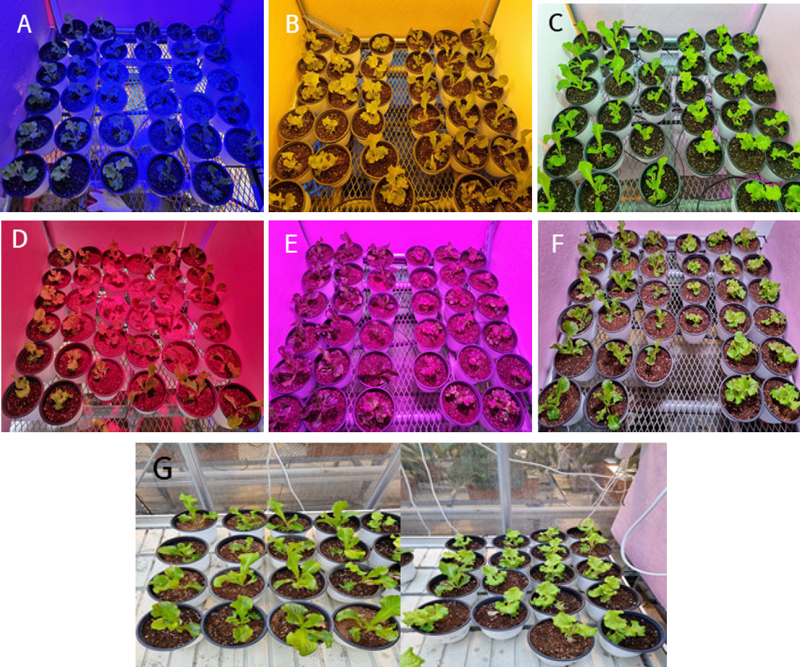
Effect of artificial light source on growth of ‘Tomalin’ and ‘Seonpunggold’ in lettuce cultivar. Artificial light source treatment : A; B-L, B; HPS, C; MH, D; R-L, E; RGB-L, F; RBGFR-L, G; Control.
The light intensities of each artificial light source were as follows: HPS lamp: 45 μmol/m2·s, MH lamp: 14 μmol/m2·s, R-L: 153 μmol/m2·s, B-L: 149 μmol/m2·s, RGB-L: 58 μmol/m2·s, RGBFR-L: 91 μmol/m2·s, and the control group was 77 μmol/m2·s.
Lux values for each light source were measured at three different points in the cultivation pots using a lux meter (ANA-F9, Tokyo Photo-Electric CO. LTD, Japan), and the average value was calculated. The lux value for the control group was measured at 12:30.
2.3. Assessment of lettuce growth and quality under artificial light treatment
The growth assessment of lettuce was conducted on days 15, 22, 29, and 36 after transplantation. Growth parameters including number of leaves, leaf area, leaf length, leaf width, leaf shape index, plant height, root length, fresh weight, dry weight, and relative growth rate were examined. For each measurement, three plants per replicate were sampled. Number of leaves was determined by counting leaves with an area greater than 1 cm2, while leaf area was measured using a leaf area meter (LI-3000, LI Cor., USA).
The leaf length and leaf width were measured on the third fully expanded true leaf, while the plant length was measured as the longest part of the above ground portion. The root length was measured after washing the roots with water to remove soil, measuring the longest part of the root. Fresh weight was determined by weighing the plant, and dry weight was measured after drying the plant at 70°C for 24 hours. The relative growth rate was calculated using the following formula.
RGR ; Relative growth rate
Wa : Plant dry weight(g) of ta after transplanting
Wb : Plant dry weight(g) of tb after transplanting
Chlorophyll content, anthocyanin content, and color index were measured on days 15, 22, 29, and 36 after transplanting. Chlorophyll content was measured by taking three readings at three different points on the third fully expanded true leaf using a Chlorophyll meter (SPAD-502, Minolta Co., Ltd., Japan), and then averaging the values.
The lettuce harvested by each treatment was freeze-dried to obtain 1 g, then crushed using a mortar and pestle with a mixture of Ethanol and 1.5 N HCl in a ratio of 85:15 (v/v) in a 10 ml solution. Afterward, the mixture was centrifuged at 5000 rpm for 10 minutes using a Hanil MICRO 17TR centrifuge (Korea), and the supernatant was filtered through Whatman No.2 filter paper. The supernatant was then diluted with a mixture of Potassium chloride buffer (0.025 M, pH 1.0) and Sodium acetate buffer (0.4 M, pH 4.5) in a 1:1 (v/v) ratio for 15 minutes. After dilution, absorbance was measured at 520 nm and 700 nm by using a Spectrophotometer (Mecasys Optizen 3220UVbio, Korea), and the anthocyanin content was determined. Absorbance (A) and anthocyanin content were calculated as follows.
MW : molecular weight of cyanidine-3-glucoside=449.2
DF : dilution factor
ɛ : molar absorptivity=26900
Colorimetry involved selecting leaves with average color for each treatment by using a colorimeter (CM-3500d, Minolta, Japan) to measure Hunter L, a, and b values. The mean values were then calculated. L value ranges from 0 (Black) to +100 (White), a value indicates +a (Redness) or -a (Greenness), and b value indicates +b (Yellowness) or –b (Blueness).
2.4. Statistical analysis
Statistical analysis was conducted by using the SAS program (Version SAS 9.4, SAS Institute Inc., Cary, NC, USA), and Duncan's multiple test was performed at a 95% confidence level.
3. Results and Discussions
3.1. The effect of artificial light treatment on growth of lettuce
The investigation of various artificial light sources on lettuce cultivation at different stages is presented in Table 1. In both cultivars, the highest number of leaves was observed in the RGB-L treatment. For instance, in the 'Tomalin' cultivar, after 36 days post-sowing, the number of leaves in the control group was 12.3, whereas in the RGB-L treatment, it was 25, more than double that of the control group. Also, in the 'Seonpunggold' cultivar, the untreated group had 9.0 leaves after 36 days, whereas the RGB-L treatment had 16.7 leaves, 1.86 times more than the control group. However, there was no significant difference between the HPS and RGBFR-L treatments.

Effect of artificial light source on number of leaves, leaf area for various growth state of ‘Tomalin’ and ‘Seonpunggold’ lettuce at 20℃ in greenhouse
Leaf area also varied according to the artificial light source, with significant differences observed. In the 'Tomalin' cultivar, after 36 days, the leaf area under HPS treatment was 1781.8 cm2, more than double that of the control group. Similarly, in 'Seonpunggold', the leaf area was highest at 1464.2 cm2 after 36 days under HPS treatment. Conversely, single LED treatments, including R-L, and B-L showed lower growth compared to RGB-L and RGBFR-L treatments, where various light qualities were mixed (Table 1). Particularly, in B-L, R-L, and MH treatments, the leaf area was lower, reflecting the effect of light quality, but it is also interpreted that the lower light intensity may have played a role as a contributing factor.
Leaf length and leaf width growth in lettuce were best in both 'Tomalin' and 'Seonpunggold' cultivars under HPS treatment. Conversely, in the MH treatment, leaf length and leaf width growth were lower than the control group throughout the entire growth period (Table 2). Among the light spectrum, blue light in the range of 400-520 nm promotes leaf growth, while red light in the range of 610-720 nm promotes flowering and fruit set (Xu et al., 2016). However, in this study, both cultivars showed lower leaf growth under R-L and B-L single light treatments compared to RGB-L, which combines red, green, and blue light, and RGBFR-L, which combines red, green, blue, and far-red light.

Effect of artificial light source on leaf length, leaf width for various growth state of ‘Tomalin’ and ‘Seonpunggold’ lettuce at 20℃ in greenhouse
Therefore, even for the same crop, there were slight differences in growth responses to light quality depending on the cultivar (Shin et al., 2012; Kim et al., 2020).
Lettuce was cultivated under different types of artificial light sources to investigate the effect of light quality on leaf shape index (leaf length/leaf width) of the plants (Fig. 2). In the 'Tomalin' cultivar, there was a tendency for a higher leaf shape index in plants cultivated under R-L single light source, but the difference was not significant. On the other hand, in the 'Seonpunggold' cultivar, plants cultivated under HPS light source exhibited the highest leaf shape index.
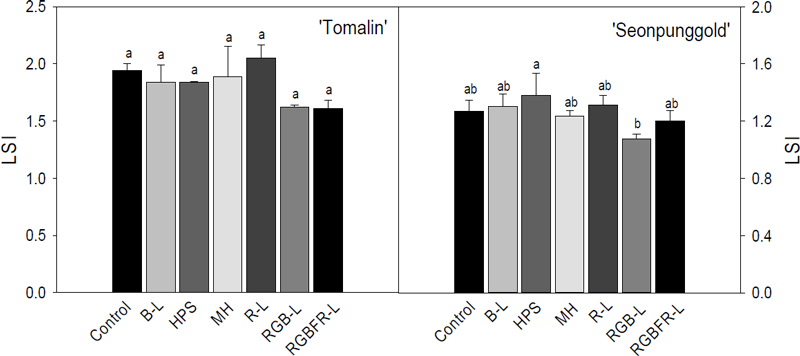
Effect of artificial light source on leaf shape index for 36 days growth of ‘Tomalin’ and ‘Seonpunggold’ lettuce at 20℃ in greenhouse. Artificial light source treatment B-L; Blue LED, HPS; High-pressure sodium lamp, MH: Metal halide lamp, R-L; Red LED, RGB-L; Red + Green + Blue LED, RGBFR-L; Red + Green + Blue + Far-Red LED. Vertical bars are means ± SE of three measurements. Means separation at P = 0.05 with Duncan's multiple range test.
According to Lee et al.(2010), an increase in the proportion of blue light (Blue LED) in both single blue light (B-L) treatment and mixed light treatments leads to a decrease in the leaf shape index. Consistent with this finding, in this study, when blue light was mixed in artificial light sources such as RGB-L, lettuce exhibited a lower leaf shape index, characterized by longer leaf length and narrower leaf width.
Indeed, it is known that an increase in the proportion of blue light (B-L) leads to thicker leaves, inhibiting length growth, and consequently resulting in shorter plants (Son and Oh, 2015). On the other hand, it is known that in R-L treatment, both leaf and plant length increase (Lee et al., 2010).
Both 'Tomalin' and 'Seonpunggold' cultivars exhibited a tendency for shorter plant length under RGB-L treatment (Fig. 3). This result aligns with the findings in Fig. 5, where lettuce seedlings treated with RGB-L had the shortest relative growth rate. 'Tomalin' showed the best plant height growth under R-L treatment, while 'Seonpunggold' performed best under RGB-L treatment in terms of plant height.
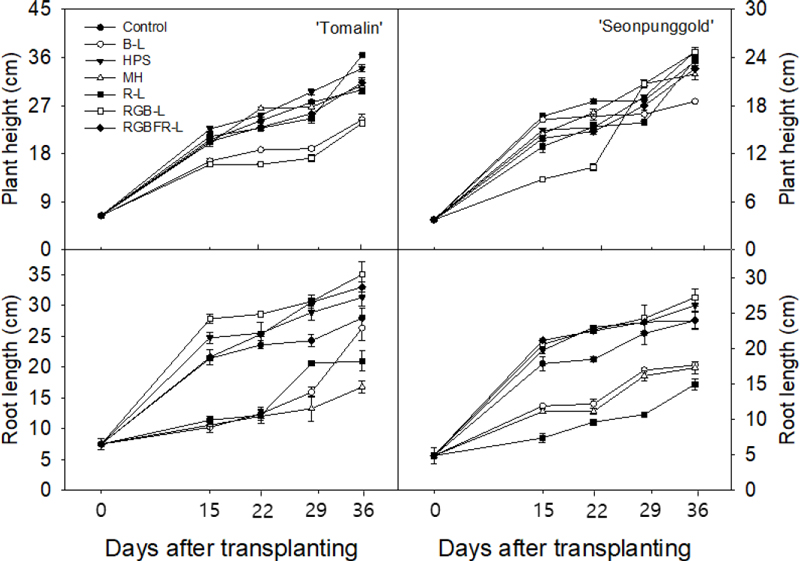
Effect of artificial light source on plant height and root length for various growth state of ‘Tomalin’ and ‘Seonpunggold’ lettuce at 20℃ in greenhouse. Artificial light source treatment B-L; Blue LED, HPS; High-pressure sodium lamp, MH: Metal halide lamp, R-L; Red LED, RGB-L; Red + Green + Blue LED, RGBFR-L; Red + Green + Blue + Far-Red LED. Vertical bars are means ± SE of three measurements.
Root length was highest in RGB-L with a high proportion of blue light (Blue LED). On the other hand, ‘Tomalin' cultivar showed the lowest root length under MH treatment, while 'Seonpunggold' cultivar showed the lowest root length under R-L treatment.
The investigation of lettuce cultivation under various light qualities to examine the effect of artificial light sources on the fresh weight and dry weight of lettuce revealed that both 'Tomalin' and 'Seonpunggold' cultivars exhibited higher fresh weight and dry weight under RGB-L treatment compared to R-L, B-L, and RGBFR-L treatments, which included far-red light.
The lettuce plants of the 'Tomalin' cultivar cultivated under RGB-L light for 36 days had a fresh weight of 106.19 g and a dry weight of 6.07 g. In comparison, the fresh weight of plants in the control group was 46.979 g, with a dry weight of 2.20 g. These results indicate that the plants grown under RGB-L light had a fresh weight 2.78 times higher and a dry weight more than 3 times higher than those in the control group. Additionally, lettuce cultivated under HPS light also exhibited significantly higher fresh weight and dry weight compared to the control group.
In general, the dry weight was highest throughout the entire growth period under RGB-L treatment. Additionally, the mixed light source treatment, RGBFR-L, which included far-red light, resulted in the higher dry weight compared to R-L and B-L single light treatments.
This indicates that mixed light treatments combining red light, blue light, and far-red light are more effective in enhancing photosynthesis compared to single light source treatments (Ouzounis et al., 2015). Particularly, the promotion of lettuce growth by far-red light is consistent with the findings of Li and Kubota(2009).
Light quality also influences plant morphology, and it is known that in blue led (B-L), stimulation of mesophyll tissue in the leaves leads to an increase in quantum yield and energy, resulting in thicker leaf tissues and promoting robust growth (Okamoto, 1996; Xiao et al., 2011).
In this study, when comparing R-L and B-L treatments, both cultivars showed higher fresh weight and dry weight under B-L treatment, but the difference between treatments was not recognized (Table 3, 4). On the other hand, plants cultivated under MH light source exhibited lower fresh weight and dry weight compared to the control group. This is attributed to the lower light intensity of MH at 50 μmol/m2·s compared to other artificial light sources, resulting in delayed growth due to insufficient photosynthesis.

Effect of artificial light source on fresh and dry weight for various growth state of ‘Tomalin’ lettuce at 20℃ in greenhouse

Effect of artificial light source on fresh weight and dry weight for various growth state of ‘Seonpunggold’ lettuce at 20℃ in greenhouse
The T/R ratio, according to the artificial light source, was highest in both cultivars under MH treatment (Fig. 4). This indicates not only lower fresh weight and dry weight under MH but also poor above-ground growth. On the other hand, the T/R ratio was lowest under RGBFR-L, but there was no statistically significant difference compared to other artificial light treatments.
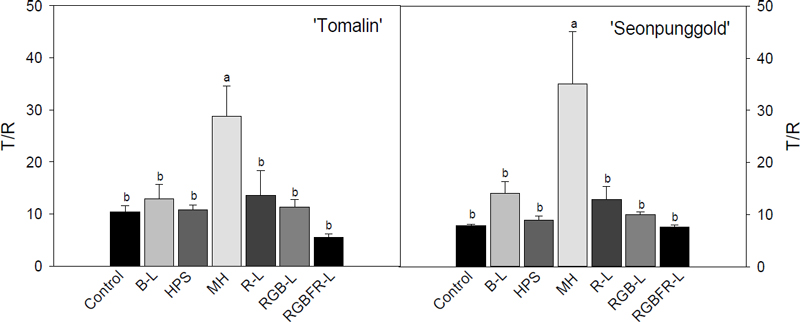
Effect of artificial light source on T/R for 36 days growth of ‘Tomalin’ and ‘Seonpunggold’ lettuce at 20℃ in greenhouse. Artificial light source treatment B-L; Blue LED, HPS; High-pressure sodium lamp, MH: Metal halide lamp, R-L; Red LED, RGB-L; Red + Green + Blue LED, RGBFR-L; Red + Green + Blue + Far-Red LED. Vertical bars are means ± SE of three measurements. Means separation at P = 0.05 with Duncan's multiple range test.
The relative growth rate of lettuce plants after cultivation under different artificial light sources is shown in Fig. 5. In the case of the 'Tomalin' cultivar, the relative growth rate was highest under RGB-L treatment, followed by RGBFR-L treatment, and then HPS treatment. For 'Seonpunggold', the relative growth rate was highest under HPS treatment, followed by RGBFR-L treatment, and then RGB-L treatment.
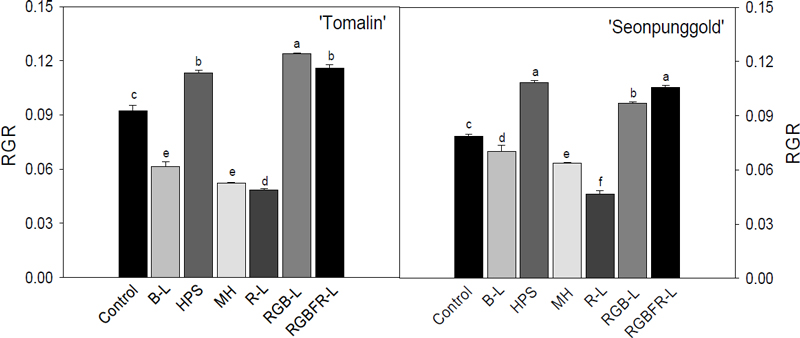
Effect of artificial light source on relative growth rate for 36 days growth of ‘Tomalin’ and ‘Seonpunggold’ lettuce at 20℃ in greenhouse. Artificial light source treatment B-L; Blue LED, HPS; High-pressure sodium lamp, MH: Metal halide lamp, R-L; Red LED, RGB-L; Red + Green + Blue LED, RGBFR-L; Red + Green + Blue + Far-Red LED. Vertical bars are means ± SE of three measurements. Means separation at P = 0.05 with Duncan's multiple range test.
On the contrary, both varieties exhibited lower relative growth rates under single-light treatments such as B-L, R-L, and MH compared to the control group. Plant responses to light intensity, vary among crops, but generally, lower light intensity leads to poor overall growth, including leaf area and fresh weight (Ju et al., 2009; Yoon et al., 2015). Indeed, the lower relative growth rates observed under single light treatments such as B-L, R-L, and MH compared to the control group suggest growth delay due to inadequate photosynthesis compared to sunlight.
3.2. The effect of artificial light treatment on the quality of lettuce
The effect of different artificial light sources on the chlorophyll content of lettuce was investigated (Table 5). There were differences in chlorophyll content depending on the type of artificial light source. Both 'Tomalin' and 'Seonpunggold' cultivars exhibited the highest chlorophyll content under RGB-L and RGBFR-L treatments. In contrast, plants cultivated under single-light treatments such as B-L and R-L had lower chlorophyll content. Light quality and intensity influence chlorophyll content (Kim et al., 2009; Lee et al., 2011), with higher light intensity leading to higher chlorophyll content (Lee et al., 2011; Kim et al., 2018).

Effect of artificial light source on chlorophyll content for various growth state of ‘Tomalin’ and ‘Seonpunggold’ lettuce at 20℃ in greenhouse
In this study, the higher chlorophyll content was observed under mixed light treatments such as RGB-L and RGBFR-L, and this is interpreted as a result of the interaction between light quality and intensity. These results suggest that artificial light treatments could enhance the productivity of lettuce during the winter months when daylight becomes insufficient. Furthermore, mixed light treatments containing red, green, and blue light are deemed more effective for promoting growth compared to single light sources.
The anthocyanin content varied depending on the type of artificial light source. Also, there was a tendency that anthocyanin content to increase when growth period progress (Table 6). Blue light is known to play a role in the expression of anthocyanins through cryptochrome, which acts as a photoreceptor (Ninu et al., 1999). Additionally, the expression of chalcone synthase and dihydroflavonol-4-reductase (DFR) is promoted by blue light, which is reported to regulate anthocyanin synthesis (Meng et al., 2004).

Effect of artificial light source on anthocyanin content for various growth state of ‘Tomalin’ and ‘Seonpunggold’ lettuce at 20℃ in greenhouse
Among the single artificial light sources, B-L resulted in a higher anthocyanin content than R-L for both cultivars throughout the entire growth period. However, the anthocyanin content was higher under mixed light treatments such as RGB-L and RGBFR-L compared to single light treatments including B-L and R-L.
In particular, the anthocyanin content of the plants increased under RGB-L treatment. After 36 days of cultivation, 'Tomalin' exhibited an anthocyanin content of 8.37 mg/100 g under RGB-L treatment, which was more than 7 times higher than the control group. Similarly, 'Seonpunggold' showed an anthocyanin content of 5.31 mg/100 g under RGB-L treatment, which was more than 5 times higher than the control group.
This finding is similar to previous research, such as Nishimura et al.(2009), which reported an increase in anthocyanin content under light sources where red LEDs (R-L) and blue LEDs (B-L) were mixed.
It is known that day length and temperature influence the expression of anthocyanins in lettuce. Higher temperatures and longer day length lead to an increase in anthocyanin content in lettuce cultivation (Joo and Lim, 2000). Additionally, it has been reported that in red-pigmented lettuce cultivars like 'Lactuca Sativa Va', anthocyanin content increases as the duration of exposure to light increases (Choi et al., 2014).
In the case of 'Seonpunggold', a Lactuca Sativa Va, the anthocyanin content was higher in all artificial light treatments compared to the control group, regardless of the type of artificial light source. However, for 'Tomalin', a black skirt lettuce cultivar, the anthocyanin content was lower than the control group in MH and R-L treatments. Therefore, it can be concluded that there are differences in anthocyanin expression depending on the cultivar, even within the same crop (Table 6).
The Hunter L, a, and b values of lettuce varied significantly depending on the type of artificial light source (Table 7, 8). In the control group, which typically had lower chlorophyll content, exhibiting a lighter green color, the Hunter L value was higher, indicating higher brightness of the leaves. Hunter a value represents the expression of red color, and both cultivars showed higher Hunter a value under RGB-L treatment. Hunter L value is an indicator of leaf brightness, and under R-L treatment, L value was higher, indicating the brightest leaf color.

Effect of artificial light source on chromaticity for various growth state of ‘Tomalin’ lettuce at 20℃ in greenhouse
Under RGB-L treatment, the Hunter a value was high, while the L and b values were low, resulting in a dark green color with a reddish hue (Fig. 6, 7). This could be attributed to the promotion of anthocyanin expression under RGB-L treatment, leading to a reddish coloration of the leaves. Similar results have been reported in previous studies; for example, in the cultivation of young radish sprouts, the treatment with a combination of blue and red light resulted in the highest Hunter a value and the lowest Hunter L value (Kim, 2009).
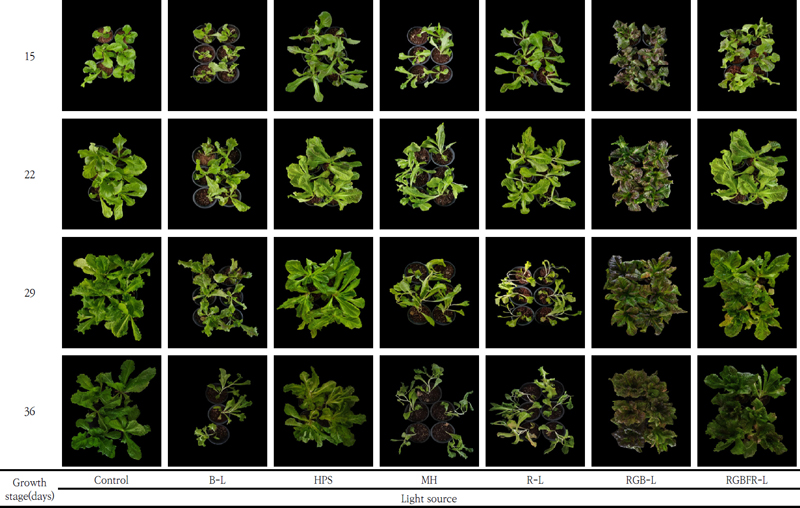
Changes in growth of ‘Tomalin’ lettuce by different light source treatment 15, 22, 29 and 36 days after transplanting at 20℃ in greenhouse. Artificial light source treatment is as shown in Fig. 1.
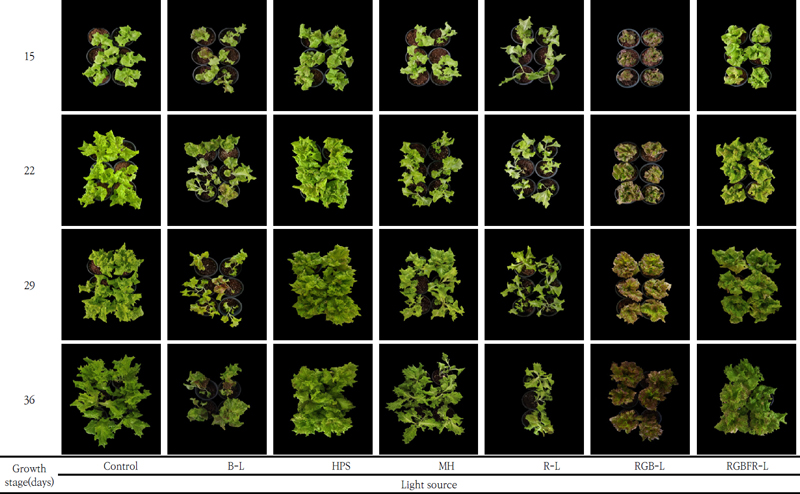
Changes in growth of ‘Seonpunggold lettuce by different light source treatment 15, 22, 29 and 36 days after transplanting at 20℃ in greenhouse. Artificial light source treatment is as shown in Fig. 1.
In 'Seonpunggold', the RGB-L treatment exhibited the highest Hunter a and b values, while there were no significant differences observed among the other artificial light treatments compared to the control group (Table 8 and Fig. 7).

Effect of artificial light source on chromaticity for various growth state of ‘Seonpunggold’ lettuce at 20℃ in greenhouse
It appears that 'Tomalin' exhibited significant color changes in response to the quality of artificial light sources, whereas 'Seonpunggold' showed smaller variations in color based on the quality of light compared to 'Tomalin'.
4. Conclusion
This research aimed to investigate the effects of artificial light sources on the growth and quality of lettuce to identify the optimal artificial light source for producing high-quality lettuce. Variations in lettuce growth and quality were observed depending on the type of artificial light source. The RGB-L treatment resulted in thick leaf development, leading to higher fresh weight, dry weight, and relative growth rates. Additionally, both cultivars exhibited higher anthocyanin content and a darker reddish leaf coloration under the RGB-L treatment.
Furthermore, both RGBFR-L and HPS treatments resulted in a larger leaf area and superior growth compared to the control group. In contrast, treatments with single light sources such as R-L, B-L, and MH exhibited lower plant growth compared to treatments with a combination of red, green, and blue light like RGB-L or a combination of red, green, blue, and far-red light like RGBFR-L.
Both 'Tomalin' and 'Seonpunggold' exhibited the highest chlorophyll content under RGB-L and RGBFR-L treatments. In contrast, treatments with single light sources such as B-L and R-L resulted in lower chlorophyll content in the plants. Particularly, under R-L treatment, the plants showed elongated leaves with narrow widths, resulting in a higher leaf shape index and a tendency towards leaf curling.
The anthocyanin content was highest under the RGB-L light treatment. Specifically, on the 36th day after planting, the 'Tomalin' exhibited anthocyanin levels more than 7 times higher than the control group, while the 'Seonpunggold' showed anthocyanin levels more than 5 times higher than the control group.
Therefore, for the improvement of lettuce growth and quality, it is more effective to use RGB-L lighting where red, blue, and green lights are appropriately mixed, rather than single light sources.
Acknowledgments
This work was supported by a 2 year research grant of Pusan National University.
REFERENCES
-
Briggs, W. R., 1993, New light on stem growth, Nature, 366, 110-111.
[https://doi.org/10.1038/366110a0]

-
Choi, M. G., Bake, G. Y., Kwon, S. J., Yoon, Y. C., Kim, H. T., 2014, Effect of LED light wavelength on lettuce growth, vitamin C and anthocyanin contents, Protected Horticulture and Plant Factory, 23, 19-25.
[https://doi.org/10.12791/KSBEC.2014.23.1.019]

-
Hwang, M. K., Huh, C. S., Seo, Y. J., 2004, Optic characteristics comparison and analysis of SMD type Y/G/W HB LED, Journal of the Korean institute of llluminating and Electrical installation Engineers, 18, 15-21.
[https://doi.org/10.5207/JIEIE.2004.18.4.015]

- Joo, M. K., Lim, J. S., 2000, Effect of light and temperature on yield, chlorophyll and anthocyanin contents of leaf lettuce (Lactuca sativa L.), Kor. J. Intl. Agri., 14, 105-112.
- Ju, J. H., Kim, S. H., Bang, K, J., 2009, Effect of light intensity of fluorescent lamp on the indoor plants in simulation subway interior landscape, J. Kor. Soc. People Plants Environ, 12, 15-24.
-
Kim, H. G., Lee, J. S., Kim, Y. H., 2018, Chlorophyll fluorescence, chlorophyll content, graft-taking, and growth of grafted cucumber seedlings affected by photosynthetic photon flux of LED lamps, Protected Horticulture and Plant Factory, 27, 231-238.
[https://doi.org/10.12791/KSBEC.2018.27.3.231]

- Kim, Y. D,, Han, S. J., Lee, J. H., Choi, I. L., Kwon, H. J., Roh, H. Y., Yoo, H. Y., Kang, H. M. 2020, Influence of light quality on the growth of baby romaine lettuce, Journal of ALES, 32, 108-115.
- Kim, Y. H., Kim, D. E., Lee, G. I., Kang, D. H., Lee, H. J., 2011, Current status and development direction of the domestic and overseas for the artificial plant factory, Kor. J. Horti. Sci. Technol., 29, 37.
- Kim, Y. S, 2009, Effect of LEDs light on the growth and nutritional composition of R-L radish sprout vegetable, Jeonnam Provincial College Paper, 11, 147-154.
- Lee, J. G., Oh, S. S., Cha. S. H., Jang, Y. A., Kim, S. Y., Um, Y. C., Cheong, S. R., 2010, Effects of red/blue light ratio and shortterm light quality conversion on growth and anthocyanin, J. Bio-Environment Control, 19, 351-359.
-
Lin, K. H., Huang, M. Y., Huang, W. D., Hsu, M. H., Yang, Z. W., Yang, C. M., 2013, The effects of red, blue, and white light-emitting diodes on the growth development, and edible quality of hydroponically grown lettuce (Lactuca sativa L. var. capitata), Sci. Hort., 150, 86-91.
[https://doi.org/10.1016/j.scienta.2012.10.002]

-
Li, Q., Kubota, C., 2009, Effects of supplemental light quality on growth and phytochemicals of baby leaf lettuce, Environ. Exper. Bot., 67, 59-64.
[https://doi.org/10.1016/j.envexpbot.2009.06.011]

-
Massa, G. D., Kim, H. H., Wheeler, R. M., Mitchell, C. A., 2008, Plant productivity in response to LED lighting, HortScience, 43, 1951-1956.
[https://doi.org/10.21273/HORTSCI.43.7.1951]

-
Meng, X. C., Xing, T., Wang, X. J., 2004, The role of light in the regulation of anthocyanin accumulation in Gerbera hybrida, Plant Growth Regulation, 44, 243-250.
[https://doi.org/10.1007/s10725-004-4454-6]

-
Nishimura, T., Ohyama, K., Goto, E., Inagaki, N., 2009, Concentrations of perillaldehyde, limonene, and anthocyanin of perilla plants as affected by light quality under controlled environments, Scientia Horticulturae, 122, 134-137,
[https://doi.org/10.1016/j.scienta.2009.03.010]

-
Ninu, L., Ahmad, M., Miarelli, C., Cashmore, A. R., Giuliano, G., 1999, Cryptochrome 1 controls tomato development in response to B-L light, Plant J., 18, 551-556.
[https://doi.org/10.1046/j.1365-313X.1999.00466.x]

-
Nozue, H., Shimada, A., Taniguchi, Y., Nozue. M., 2010, Improving the productivity of plants using an LED light equipped with a control module, J. SHITA, 22, 81-87.
[https://doi.org/10.2525/shita.22.81]

-
Okamoto, K. Yanagi, T., Takita, S., Tanaka, M., Higuchi, T., Ushida, Y., Watanabe, H., 1996, Development of plant growth apparatus using B-L and R-L LED as artificial light source, Acta Hort., 440, 111-116.
[https://doi.org/10.17660/ActaHortic.1996.440.20]

-
Ouzounis, T., Rosenqvist, E., Ottosen, C., 2015, Spectral effects of artificial light on plant physiology and secondary metabolism: a review, Horti, Sci., 50, 1128-1135.
[https://doi.org/10.21273/HORTSCI.50.8.1128]

-
Park, Y. G., Park, J. E., Hwang, S. J., Jeong, B. R., 2012, Light source and CO2 concentration affect growth and anthocyanin content of lettuce under controlled environment, Hort. Environ. Biotechnol., 53, 460-466.
[https://doi.org/10.1007/s13580-012-0821-9]

-
Shin, K . S., Murthy, H. N., Heo, J. W., Hahn, E. J., Paek, K. Y.. 2008, The effect of light quality on the growth and development of in vitro cultured Doritaenopsis plants, Acta Physiol. Plant, 30, 339-343.
[https://doi.org/10.1007/s11738-007-0128-0]

- Shin, Y. S., Lee, M. J., Lee, E. S., Ahn, J. H., Lim, J. H., Kim, H. J., Chai, J. H., 2012, Effect of LEDs (Light Emitting Diodes) irradiation on growth and mineral absorption of lettuce (Lactuca sativa L. ‘Lollo Rosa’), J. Bio-Environ Cont., 21, 180-185.
-
Xu, Y., Chang, Y., Chen, G., Lin, H., 2016, The research on LED supplementary lighting system for plants, Optik, 127, 7193-7201.
[https://doi.org/10.1016/j.ijleo.2016.05.056]

-
Xiao, Y. L., Shirong, G., Zhigang, X., Xuelei, J., Tezuka, T., 2011, Regulation of chloroplast ultrastructure, cross-section anatomy of leaves, and morphology of stomata of cherry tomato by different light irradiations of light emitting diodes, HortScience 46, 217-221.
[https://doi.org/10.21273/HORTSCI.46.2.217]

- Yoon, S. T., Jeong, I. H., Kim, Y. J., Han, T. K., Yu, J. B., Jae, E. K., 2015, Response of growth and functional components in baby vegetable as affected by LEDs source and luminous intensity, Korean J. Organic Agri., 23, 549-565.
-
Yorio, N. C., Goins, G. D., Kagie, H. R., Wheeler, R. M., Sager, J. C., 2001, Improving spinach, radish, and lettuce growth under red light-emitting diodes (LEDs) with blue light supplementation, HortScience, 36, 380-383.
[https://doi.org/10.21273/HORTSCI.36.2.380]

Department of Horticulture Bioscience, Pusan National Universityevery921004@naver.com
Department of Horticulture Bioscience, Pusan National Universityjujujjk5734@naver.com
Department of Horticulture Bioscience, Pusan National Universitydanggeun00@gmail.com
Department of Horticulture Bioscience, Pusan National Universityfloodbi@hotmail.com
Department of Plant Bioscience, Pusan National Universityssm6537@gmail.com
Department of Horticulture Bioscience, Pusan National Universitykangjs@pusan.ac.kr